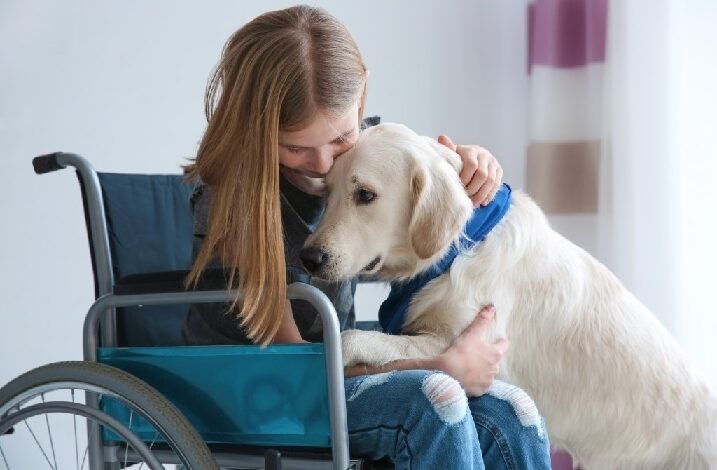From Pet to Service Animal: Navigating the Transition Process

Pets are amazing companions. They’re loving and loyal and, in some cases, make fantastic partners for people with disabilities. More than one in four (28.7%) American adults have some type of disability. And some of them have service animals. (1)
Most service animals come from non-profit organizations or charities. But did you know you can train your house pet to have this noble role? It’s a challenging task and a huge commitment. However, it’s possible. Read on to learn how to turn your beloved furry friend from pet to service animal.
Understanding Service Animals
Service animals have more responsibilities than the average pet. They also undergo more training than the obedience basics.
Unlike an emotional support animal (ESA) or a therapy animal, a service animal has public access rights under the Americans with Disabilities Act (ADA). You may need to receive an ESA letter online or in-person to be allowed to have an ESA with you in certain places. Meanwhile, service dogs typically don’t need proof.
It’s also important to remember that not every pet or breed can be a service animal. An assistance animal must have the proper temperament, especially when assisting people with PTSD. Around 29% of post-9/11 veterans have been diagnosed with PTSD, and these people need good-tempered dogs to help them counter bouts of panic attacks. (2)
Assessing Your Pet’s Potential
A suitable service animal candidate is typically calm, obedient, and eager to learn. Trainability is key. While certain breeds like Labrador Retrievers, Golden Retrievers, and Great Danes are often used, any dog can be a service animal with proper training. Mixed breeds and small breeds like Pomeranians also make great assistance animals.
Early socialization is vital for building good behavior and preventing fear-based issues. According to several studies, nearly 10% to 19% of dogs display fear of strangers or other dogs, which can be an issue if you’re training your dog from pet to service animal. (3)
The Training Process
Every service dog must undergo training. They need to be able to assist you whether you’re at home or out in public. Hence, proper training is necessary.
Basic Obedience Training
A solid foundation in basic obedience is the first step in your pet’s journey to becoming a service animal. Start with the basics: ‘sit,’ ‘stay,’ ‘come,’ and ‘leave it.’ Nailing these commands is a must for any top-notch service dog. Positive reinforcement is important here – rewards and praise go a long way in motivating your dog.
Stick to the training. The more you stay on track, the quicker your pet will catch on and know exactly what you’re after.
Service Animal-Specific Training
Now, it’s time to teach your dog the specific tasks it’ll need to perform as a service animal. What exactly your dog will do depends on your individual needs. Your pup might end up fetching stuff, swinging doors open, lending a paw during seizures, or giving you a heads-up when blood sugar levels go awry.
You’ve got choices: train your dog or enlist a dog training company for help. Either way, having a solid plan will keep you organized and focused.
Public Access Training
Exposing your dog to different environments is essential for successful public access work. Take them to various places like stores, restaurants, and public transportation.
The endgame? Getting your dog to tune out distractions and act like a pro in public. Knowing your rights as a handler is also crucial. It’ll help you tackle any bumps in the road or unfair treatment head-on.
Legal Rights and Considerations
ADA protects the rights of people with disabilities and their service animals. Your service animal has the right to accompany you in most public places.
Don’t forget to brush up on local and state laws – they might have extra rules up their sleeves. Certificates aren’t always a must, but they may come in handy. Most importantly, anticipate challenges and be prepared to advocate for your and your dog’s rights.
Your Pet’s Transition
This journey from pet to service animal isn’t just about your dog – you’re in for a transformation, too!
Adjusting Life With Your New Service Animal
Transforming your pet into a service animal means making some adjustments to your daily routine. Your furry friend’s life is changing, and so is yours. Make sure your dog gets enough exercise to keep their mind and body sharp. Every dog is different, so find a workout routine that suits you both.
Remember the practicalities. You might need a harness or vest. Also, keep those vet visits and good meals coming—they’re crucial for your service animal’s success.
The Emotional Ups and Downs
Since they’re already your pet, just with a new job title, the bond you have with your service animal is already strong. However, the journey won’t always be smooth. There will be setbacks and challenges during training, times when you might feel frustrated or overwhelmed.
If you’re feeling lost, reach out to other service dog owners for sage advice. And celebrate the small victories along the way. Every milestone, every new command learned is a cause for celebration!
Wrapping Up
Transforming your furry companion from pet to service animal is an incredible journey filled with both heartwarming rewards and challenging hurdles. Get ready to flex your patience muscles and really tune into your furry friend’s needs. Not every dog is cut out for the rigors of service work, so be honest with yourself about your pet’s abilities.
Keep training, care for them well, and shower them with love, and you’ll build an incredible bond with your service dog.
References
- “Disability Impacts All of Us,” Source: https://www.cdc.gov/ncbddd/disabilityandhealth/infographic-disability-impacts-all.html
- “Service dogs can reduce the severity of PTSD for veterans – new research,” Source: https://theconversation.com/service-dogs-can-reduce-the-severity-of-ptsd-for-veterans-new-research-231912
- “Inadequate socialisation, inactivity, and urban living environment are associated with social fearfulness in pet dogs,” Source: https://www.nature.com/articles/s41598-020-60546-w













